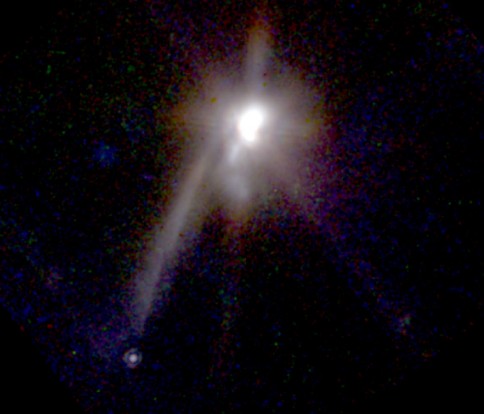Discovery Space News | 31 Aug 2010
Large Amplitude Photometric Variability of the Candidate Protoplanet TMR-1C - B Riaz, EL MartinOf the hundreds of exoplanets found so far, there’s one that’s remained elusive and infamous 12 years after its purported discovery.
Once ridiculed as being a false start, it may have now returned from the dead.
The object’s formal designation is TMR-1C. It lies about 450 light-years away in the Taurus molecular cloud.
Back in 1998, astronomer Susan Tereby announced that TMR-1C could be the first exoplanet ever directly photographed. At the time Tereby cautiously called it a “candidate planet.”
The Hubble Space Telescope infrared image was compellingly believable (pictured top). A very red -- and therefore cool -- pinpoint object was at the end of a ghostly finger of illuminated dust stretching 135 billion miles from a young binary star system. The telltale finger was interpreted as being formed after the planet was gravitationally ejected from the binary system.
Astronomers were duly skeptical and accused Tereby of jumping the gun. It was not clear if the object was actually co-moving along with the double star, or even in the Taurus star-forming region. Though estimated to be less than 10 percent likely, the finger-like feature might simply be juxtaposed with a background star masquerading as a cooler planet. The object might look red only because its blue light is scattered by dust -- as we see in sunsets.
A year after this front-page news announcement, Tereby reported that follow-up spectroscopy showed it was likely a background star. Case closed. TMR-1C was just another on a long list of mistaken planets erased away by follow-on observations.
But now we have even more data spanning a decade since the Hubble observation. A team of astronomers using the Canada-France-Hawaii telescope looked at the object in 2009. They found it had gotten brighter and bluer -- a trick a star could never do on such a shot timescale unless it exploded.
They propose it is a young protoplanet surrounded by a spinning thick disk of dust. This might explain the variability if the planet’s light; the dust only periodically reddens the starlight when the disk is tilted at the right orientation to us. The researchers say they support Tereby’s initial analysis, that the object could have been “kicked off the island” by gravitational pinball in the young binary system.
Another team using the European Southern Observatory’s Very Large Telescope in Chile maintains that the object is 5,000 degrees Fahrenheit – way too hot for a planet. But they too think the very red color comes from scattering by a dusty disk.
This is a lesson to those astronomers who lambasted the initial report. They were the ones who too quickly jump the gun. There is still a lot more to be learned about TMR-1C, whatever it is.
- arXiv.org > astro-ph > arXiv:1008.1248 > 06 Aug 2010
revisit to the candidate very low-mass object TMR-1C - MG Petr-Gotzens et al
- arXiv.org > astro-ph > arXiv:1007.5153 > 29 Jul 2010
